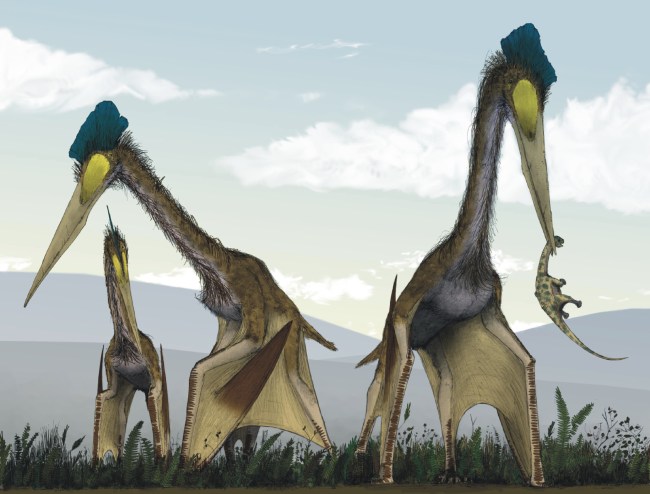Think you’ve got it rough, sitting in line for your new iPhone X and trying to come up with witty Tinder openers? Imagine being alive 70 million years ago when this legit flying monster ruled the skies and swooped down to feast on whatever animal it could fit in its gigantic bill. Paleontologists lead by Buuvei Mainbayar have unearthed this prehistoric beast in the Gobi Desert of Mongolia. When this giant flying dinosaur lived, the area was not quite as dry as it is today and would have been flourishing with dinosaurs. Which is perfect for this nightmarish creature because it snacked on baby dinosaurs and would have definitely swallowed you whole.
The stork-like flying dinosaur stood as tall as a giraffe and had the wingspan of a small plane. Researchers say that the dinosaur is in the Azhdarchidae family, which includes Quetzalcoatlus found in Texas in the 1970s. With the wingspan of up to 36-feet, the same as a Cesena plane, these are thought to be the largest flying animals to have ever inhabited the planet. The 18-foot-tall azhdarchids are pterosaurs, which means “winged lizard” in Greek and lived during the late Cretaceous period. The more popular pterodactyl is also a pterosaur, but much smaller with an adult wingspan of about 3 feet and 5 inches. Azhdarchids were carnivores, who not only stalked their prey from the skies but also walked on all fours to feed on baby dinosaurs. Despite being so massive, scientists believe azhdarchids could have thrust themselves into the sky from a standing start in a matter of seconds.
“It might have been this quite robust, formidable predator,” said Mark Witton, an expert on pterosaurs at the University of Portsmouth in the U.K. “They seem to be feeding on things on the ground and are generalist in their ability to grab basically whatever they can fit in their beaks.” Witton added, “It’s a really big vertebra, and the only thing comparable is some material from Romania. This is definitely up there with the largest pterosaurs, and there’s nothing like it from Asia so far.”
The first fossil was found in 2006, but the paper on the discovery was not published until last week in the Journal of Vertebrate Paleontology. Imagine if one of those monsters crapped on your car? Nevermind the mess, it would probably crack the windshield.
[NatGeo]
